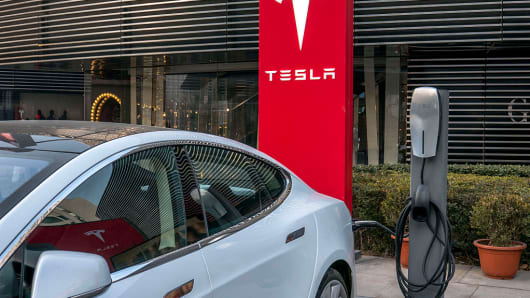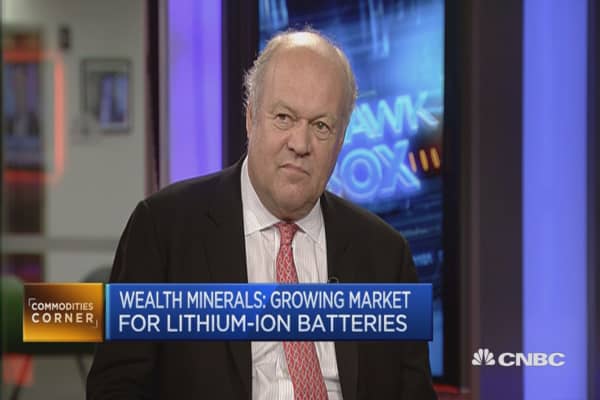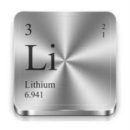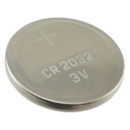Tesla to begin lithium-ion battery production at US megafactory – bodes well for $DGO.ca $BFF.ca $PFN.ca $SX.ca $FMR.ca

Elon Musk’s Tesla Motors says it has started producing lithium-ion battery cells at its $5 billion factory in Nevada.
The company says it began making high-performance cells in December and production started overnight for cells used in Powerwall energy-storage products.
Tesla plans to start making batteries for its Model 3 sedans later this year.
The massive Gigafactory outside Sparks is coming online in phases, with a goal of full operation in 2018.
Officials say it could almost double the world’s production of lithium-ion batteries, making them more affordable as the company looks beyond the luxury niche market.
The electric carmaker says it has more than 850 full-time employees, plus more than 1700 construction workers.
Nevada has promised Tesla $1.3 billion in state tax incentives based on projections that it’ll employ 6500 people at full production.
Source: https://thewest.com.au/business/startup/tesla-begins-lithium-ion-battery-production-at-us-megafactory-ng-b88347284z
Will $PFN.ca $DGO.ca $BFF.ca SX.ca supply the lithium needed to run the future’s electric cars?

Company Sifts oilfield waste for US$10,000-per-tonne #lithium

- MGX Minerals Inc. has been buying up metal and minerals permits in Alberta’s oil and gas producing regions but has no intention of mining the areas for lithium carbonate, which is used to make batteries for electric vehicles
- Jared Lazerson, MGX’s president and CEO, said the company is working to sign agreements with oil and gas producers to process their wastewater, a byproduct of oil and gas production, so the company can extract the lithium carbonate from that water, which would otherwise simply be treated like waste.
CALGARY – A tiny Vancouver-based mining company is betting Alberta’s energy sector could benefit from the rise of electric vehicles by harvesting its oilfield wastewater for lithium carbonate.
MGX Minerals Inc. has been buying up metal and minerals permits in Alberta’s oil and gas producing regions but has no intention of mining the areas for lithium carbonate, which is used to make batteries for electric vehicles.
Instead, Jared Lazerson, MGX’s president and CEO, said the company is working to sign agreements with oil and gas producers to process their wastewater, a byproduct of oil and gas production, so the company can extract the lithium carbonate from that water, which would otherwise simply be treated like waste.
MGX claims to be the “largest lithium brine land holder in Canada” with permits covering over one million barrels per day of brine production by various oil field operators throughout Alberta.
While MGX has yet to deploy a pilot project in the oilfield (a pilot is scheduled to begin in the first quarter of 2017), in December the company signed an agreement with oilsands giant Canadian Natural Resources Ltd. to work on the Sturgeon Lake region, near Grande Praire, Alta.
“Canadian Natural has allowed a third party to obtain water samples from our operations for their work in lithium carbonate,” CNRL spokesperson Julie Woo said in an email. “Beyond that, no decisions, plans or commitments have been made on the application of this technology in Canadian Natural’s operations.”
Lazerson said he hopes that MGX’s technology, for which it has filed patents, will allow oil and gas producers to help supply new energy markets, including the market for electric vehicles.
“Who better to have a big piece of the new energy sector than the energy sector?” he said. “I think there are going to be incredible efficiencies from oil and gas and new ideas as word starts to get out.”
Wood Mackenzie analysts expect lithium demand will double by 2024 as more and more consumers, especially in Europe, purchase electric vehicles.
Lithium prices have spiked in recent years because, as Wood Mackenzie noted in a November report, that lithium ion “has become the technology of choice” for electric vehicles.
The commodity is not traded on any exchange, however, and analysts say that current prices – which have reached US$10,000 per tonne – are likely to fall as new supplies become available.
“The trick isn’t finding lithium, the trick is producing it inexpensively,” Stormcrow Capital president and lithium analyst John Hykawy said in an email.
Hykawy said there are several companies attempting to produce lithium using water treatment technologies like reverse osmosis and nano-filtration but cautioned these are early-stage technologies being developed in a time of high prices.
Most of the lithium carbonate produced in the world is produced in South America’s “lithium triangle,” — the salt flats in Bolivia, Chile and Argentina — where new projects are also set to begin production.
“Prices will fall again, it might take a year or two,” Hykawy said. “But almost none of the smaller companies in the space, with the exception of Orocobre Ltd., are in a position to produce and have their profits benefit from these high prices. By the time most will be able to sell something, prices will be back to lower levels.”
MGX’s Lazerson hopes to move from a pilot project in the first quarter of next year to a full-scale commercial project by the third quarter. MGX, which trades on the alternative Canadian Securities Exchange, has seen its share price rise 110 per cent this year.
The company’s goal, Lazerson said, is to connect its water-treatment units with oil and gas operators in regions where they produce between 12,000 barrels per day to 20,000 bpd.
“Big picture, this is an add-on to oil and gas,” Lazerson said, adding that he thinks energy companies will see the value in the minerals in their waste and venture with MGX to process their water.
Financial Post
gmorgan@nationalpost.com
Twitter.com/geoffreymorgan
Source: http://business.financialpost.com/news/vancouver-mining-company-plans-to-scour-oilfield-waste-for-us10000-per-tonne-lithium?__lsa=0ccc-5bdd
Read More
Canadian Wealth Minerals to acquire Chile’s Laguna Verde lithium project

Canadian junior Wealth Minerals (TSX-V:WML) said Monday it has signed a letter of intent to acquire one of Chile’s attractive lithium projects located in the country’s north, known for its vast salt flats under which experts say there is enough of the commodity to supply the world for decades.
The project, known as Laguna Verde, comprises 23 concessions for a total of 2,438 hectares, with total inferred resource of 512,960 tonnes of lithium carbonate equivalent and 4,223,123 tonnes of potassium chloride equivalent, based on a technical report from 2010, the Vancouver-based company said.
Southern Lithium Corp. Announces Closing of First Tranche of Financing $SNL.ca
VANCOUVER, Canada / Southern Lithium Corp. (SNL)(SL5) (“Southern” or “the Company”) announces that further to its news release dated November 3, 2016, it has completed the first tranche of its non-brokered private placement of 3,322,000 units (“Units”) at a price of $0.25 per Unit for aggregate gross proceeds of $830,500 (the “Offering”).
Each Unit consists of one common share (a “Share”) and one Share purchase warrant of the Company (a “Warrant”). Each Warrant will entitle the holder to purchase one Share (a “Warrant Share”) at an exercise price of $0.35 per Warrant Share for a period of 18 months from the date of issuance until June 9, 2018; however, if the closing sales price of the Company’s Shares (or the closing bid, if no sales were reported on a trading day) as quoted on the TSX Venture Exchange (“TSX.V”) (or such other securities exchange, quotation system or market on which such common shares are listed and where a majority of the trading volume of such common shares occurs) is $0.50 or greater for a period of ten (10) consecutive trading days, the Company may, within five days of such event, provide notice by way of press release to the subscribers of early expiry, and thereafter the Warrants shall expire on that date which is thirty (30) days from the date such notice is given (the “Acceleration Clause”).
Read MoreInside construction of the world’s largest lithium ion battery storage facility
The largest battery storage system in the world will also be one of the fastest constructed in history.
In August, San Diego Gas & Electric tapped energy storage company AES to install two energy storage projects totaling 37.5 MW, 150 MWh. When completed, the larger, 120 MWh project is expected to be the single biggest lithium ion battery in service on a utility grid in the world.
Both battery facilities are expected to be online by the end of January 2017 — nothing short of miraculous in an industry where deploying assets, especially newfangled technologies, can take years.
And the companies are not alone. Southern California Edison and Tesla announced a 30 MW, 80 MWh project in September that is expected to be online even sooner, and will be the largest operating battery for a time.
Read More









